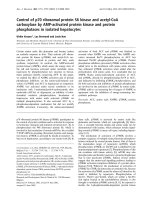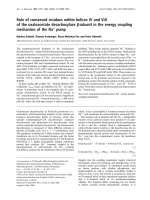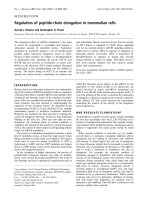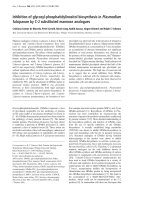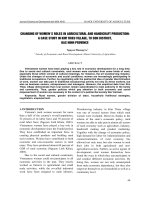Báo cáo y học: "Introduction of medical emergency teams in Australia and New Zealand: a multicentre study" pdf
Bạn đang xem bản rút gọn của tài liệu. Xem và tải ngay bản đầy đủ của tài liệu tại đây (38.75 KB, 2 trang )
Page 1 of 2
(page number not for citation purposes)
Available online />Abstract
The philosophy behind medical emergency teams (METs) or rapid
response teams leaving the intensive care unit (ICU) to evaluate
and treat patients who are at risk on the wards and to prevent or
rationalise admission to the ICU is by now well established in many
health care systems. In a previous issue of Critical Care, Jones and
colleagues report their analysis of the impact on outcomes of
METs in hospitals in Australasia and link this to reports appearing
in the world literature.
The difficulty with evaluating an intervention once it has
become part of established practice is that, like servicing a
car in motion, the method is inconvenient and the results
unreliable. Moreover, the intervention is likely to have
acquired both adherents and detractors, thereby ensuring
maximal uncertainty while impairing individual equipoise. We
are left with performing retrospective observational before-
and-after studies, relying on large numbers to minimise
confounding. This is what Daryl Jones and his colleagues [1]
have done.
Outcomes were obtained from the Australia and New
Zealand Intensive Care Society (ANZICS) database. From a
pool of 172 Australia and New Zealand hospitals, the
presence or absence of a medical emergency team (MET)
could be determined in 131, of which 84 (64%) had
established an MET. Of the 84 hospitals with an MET, 24
provided adequate data to the ANZICS database to
determine the number and rate of intensive care unit (ICU)
admissions following an in-hospital cardiac arrest, and the
proportion of ICU readmissions, one year before and one year
after implementing the MET. The comparator group was 16 of
the 47 non-MET hospitals. Comparisons were also possible
with some of the hospitals that had participated in the
Medical Emergency Response Improvement Team (MERIT)
study, the only prospective multicentre cluster-randomised
study available [2].
The authors found a reduction in the number and rate of post-
cardiac arrest ICU admissions for both the 47 MET hospitals
and 16 non-MET hospitals during the two-year period. ICU
readmission rates were unchanged, and there was no
reduction in hospital mortality for either group. These findings
are consistent with the MERIT study, which found that
adverse outcomes improved in both the MET and non-MET
hospitals. The authors suggest that the introduction of METs
has been driven not by evidence of efficacy but by evidence
of suboptimal care of acutely ill patients in hospital and an
assumption that pre-emptive intensive care would either save
lives or permit a dignified death.
How much evidence do we need before making major
changes to health service provision? Should we wait 25 years
before thrombolysis becomes the established best practice in
guidelines and textbooks [3]? Or should we follow Nike’s
approach and ‘just do it’? This was what happened with
METs, now referred to generically as rapid response teams
(RRTs) [4]. At first sight, the concept would seem to be an
eminently sensible response to the problem of suboptimal
care of acutely ill hospitalised patients: you take critical care
expertise to the patient before, rather than after, multiple
organ failure or cardiac arrest occurs. Should we not be
doing that anyway? Why do we need evidence that neglect
or inexpertise should be replaced by timely competent care?
Commentary
Introduction of medical emergency teams in Australia and
New Zealand: a multicentre study
Kaye England and Julian F Bion
Department of Critical Care and Anaesthesia, University Hospital Birmingham NHS Foundation Trust, Queen Elizabeth Medical Centre, Edgbaston,
Birmingham B15 2PR, UK
Corresponding author: Kaye England,
Published: 22 May 2008 Critical Care 2008, 12:151 (doi:10.1186/cc6902)
This article is online at />© 2008 BioMed Central Ltd
See related research by Jones et al., />ANZICS = Australia and New Zealand Intensive Care Society; DNR = do not resuscitate; ICU = intensive care unit; MERIT = Medical Emergency
Response Improvement Team; MET = medical emergency team; RRT = rapid response team.
Page 2 of 2
(page number not for citation purposes)
Critical Care Vol 12 No 3 England and Bion
The answer to this question is as complex as the system to
which the intervention has been applied. For some
intensivists, the MET was an unnecessary intrusion into the
service they were already providing. For others, it was a
perfect solution to an otherwise intractable problem. Yet
others were concerned that it would just shift the burden of
illness even more onto a service that could not cope. Ward
staff could be positive, or suspicious; ‘deskilling’ was a
common phrase, although it was probably removing responsi-
bility for patient care rather than skills that may never have
existed in the first place. Managers could be reluctant to fund
the service properly. And the recipients of the service, the
patients? Well, no one asked them. So finding out whether
METs ‘work’ is an important matter. The problem is that the
health care systems that funded METs did not want to spend
additional money on finding out whether they were effective,
and those of us involved from the beginning were unable at
that time to persuade research funders otherwise [5].
So how should we interpret the findings of this latest study?
Can those of us with RRTs close them down and put the
resources elsewhere? We would counsel caution, for the
following reasons.
First, the main problem surrounding the entire literature on
RRTs is that the publications never specify the content of the
intervention. An RRT is not an intervention: it is a vehicle for
an intervention such as sepsis bundles or early antibiotics or
a do-not-resuscitate (DNR) order or (perhaps even more
importantly) education. As in the (similarly negative) PAC-Man
study [6], the use to which the tool is put is largely unknown.
Given the diffusion of best practice, we can be reasonably
confident that non-MET hospitals will also have doctors and
nurses who want to provide good care and avoid
burdensome futile care. The MET may therefore be an
epiphenomenon for a desire to improve.
Second, should we use process or outcome measures for
evaluation? Processes of care are important not only because
they may alter outcomes (the destination), but because they
can change the way in which that outcome is achieved (the
pathway). End-of-life care is the obvious example. Last week,
our outreach nurses called one of us to an acute ward
because a junior doctor was unwilling to implement a DNR
order for a terminally ill 91-year-old man. We obtained full
consensus on treatment limitation, provided comfort care,
and contacted the patient’s son, who then spent the few
remaining hours by his father’s bedside before death
supervened. The alternative scenario would almost certainly
still have resulted in a ward death, but without dignity and
with less emotional resolution for the son. The outreach
nurses changed the process, not the outcome. They may also
have changed the junior doctor through education.
Third, it may be unwise to assume that the context in which
the intervention is applied is similar across all hospitals. A
well-staffed hospital with excellent senior staff relationships
and teamworking might find little benefit from an RRT,
whereas in another the converse conditions might prevent an
RRT from having any effect on outcomes. Differences in
patients’ severity of illness could confound the results: further
refinements of ward-based measures of severity of illness
might help in this respect [7].
Nurse-led, doctor-supported outreach care has transformed
the way in which we in the UK provide support for acutely ill
patients in ordinary wards in terms of relieving some of the
workload on intensive care doctors, supporting timely delivery
of care, improving pain relief and end-of-life care, enhancing
communication, and teaching ward nurses and doctors.
These qualitative aspects may not be reflected in immediate
changes in mortality or ICU readmissions, but they may still
be very important to patients. We are aware of John
Galbraith’s statement that ‘Faced with the choice between
changing one’s mind and proving that there is no need to do
so, almost everyone gets busy on the proof’. But perhaps the
real problem is that we have not yet properly defined the
content of the intervention, the context in which it is applied,
or the research question.
Competing interests
JFB declares an academic bias towards favouring outreach
care as an effective method of improving the quality of acute
care.
References
1. Jones D, George C, Hart GK, Bellomo R, Martin J: Introduction
of Medical Emergency Teams in Australia and New Zealand: a
multi-centre study. Crit Care 2008, 12:R46.
2. Hillman K, Chen J, Cretikos M, Bellomo R, Brown D, Doig G,
Finfer S, Flabouris A; MERIT study investigators: Introduction of
the medical emergency team (MET) system: a cluster-ran-
domised controlled trial. Lancet 2005, 365:2091-2097.
3. Antman EM, Lau J, Kupelnick B, Mosteller F, Chalmers TC: A
comparison of results of meta-analyses of randomized
control trials and recommendations of clinical experts. Treat-
ments for myocardial infarction. JAMA 1992, 268:240-248.
4. Devita MA, Bellomo R, Hillman K, Kellum J, Rotondi A, Teres D,
Auerbach A, Chen WJ, Duncan K, Kenward G, Bell M, Buist M,
Chen J, Bion J, Kirby A, Lighthall G, Ovreveit J, Braithwaite RS,
Gosbee J, Milbrandt E, Peberdy M, Savitz L, Young L, Harvey M,
Galhotra S: Findings of the first consensus conference on
medical emergency teams. Crit Care Med 2006, 34:2463-2478.
5. Cuthbertson BH: Outreach critical care—cash for no ques-
tions? Br J Anaesth 2003, 90:5-6.
6. Harvey S, Harrison DA, Singer M, Ashcroft J, Jones CM, Elbourne
D, Brampton W, Williams D, Young D, Rowan K; PAC-Man study
collaboration: Assessment of the clinical effectiveness of pul-
monary artery catheters in management of patients in inten-
sive care (PAC-Man): a randomised controlled trial. Lancet
2005, 366:472-477.
7. Cuthbertson BH, Boroujerdi M, McKie L, Aucott L, Prescott G:
Can physiological variables and early warning scoring
systems allow early recognition of the deteriorating surgical
patient? Crit Care Med 2007, 35:402-409.
